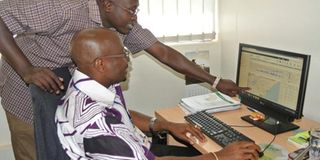Forget weatherman, you can tell yourself when rain will come

Dr Kayode Sanni (right) and David Tarus of African Agricultural Technology Foundation use the aWhere software. PHOTO | EVERLINE OKEWO |
What you need to know:
- Software is used to tell the best weather seasons for planting and harvesting.
Benson Egesa, a small-scale farmer in Alupe, Busia County is currently tilling his five-acre farm with the hope that he will get yield harvest this year.
The farmer will plant rice, maize, wheat and sweet potatoes on his one-acre land as soon as the planting season begins.
However, Egesa, like many other farmers is not sure when the rains will start so that he can know when to plant.
“Last year I planted my maize crop as soon as it rained but the rains disappeared after about two weeks,” recalls Egesa.
The dry spell saw his crops wither. “I lost about Sh20,000, which I had spent on fertiliser, seeds and ploughing the land.”
Such a misfortune, however, may be a thing of the past for Egesa and thousands of other farmers in the country since a software that helps predict rainfall and the changing weather pattern is available locally.
The weather management software called aWhere has the capacity to detect change of climate in any part of the world and alert farmers of the possible dangers.
aWhere, whose founder is John Corbett based in the US, is currently being used by seed companies that include FreshCo Kenya Limited, Afritec, Agriculture Seed Agency, Meru Agro-Tours and Consultants, East Africa Seeds, Tanseed, Kenya Agricultural and Livestock Research Organisation, Hybrids East Africa Ltd and Kenya Seed Company.
CLIMATE ALERTS
Dr Kayode Sanni, a rice project manager at African Agricultural Technology Foundation, an NGO, says aWhere processes over a billion new data on a daily basis.
“The software has weather data of about 33 years, which is used in predicting the likely temperature in different locations within a country, region or even the world. The farmer keys in the software the crop he wants to plant and the region and it will tell him when it is likely to rain or stop raining.”
The software addresses farmers’ challenges by generating climate alerts.
“Using the information, farmers and seed companies can be able to detect the temperature of their regions and predict weather patterns, thus, plan when to plant and harvest,” he says.
The software further projects the timing and place of planting and when to get the maximum yields.
“It will tell you, for instance, the temperature regime of Busia and how it will be in the next one year. If you have this information, you can develop hybrid seeds for the region.”
To use the software, one needs a computer with internet connection. A mobile phone can also be used.
“You go to the seed companies, register and they will install the programme for you and give you a password to access it for free.”
Dr John Mann, the managing director of Afritec Seed Limited says the company has been using the software for seed production since 1999.
“We have been using it specifically for hybrid rice production. It enables us to do risk assessment of the weather.”
“With aWhere, the analysis of the weather can be done to understand risks of producing hybrid seeds any time of the year,” he says.
“You need to know the temperature or precipitation of your crop of interest, then using Google Earth locate your farm, then key these particulars into aWhere, which gives you chances if such conditions can be met in that area,” explains Electine Wafula, a research scientist at Hybrids East Africa Ltd.





